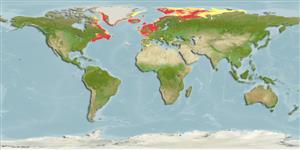Common names from other countries
Environment: milieu / climate zone / depth range / distribution range
বাস্তুসংস্থান
; গভীরতার পরিসীমা 0 - 265 m (Ref. 119532). Polar; 82°N - 35°N, 70°W - 116°E
Northern Atlantic, Arctic and the Mediterranean: from Ungava, Canada to Morocco in the south, north to Arkhangelsk Russia and west to Laptev Sea. Mostly polar, but also in subtropical and boreal.
Length at first maturity / আকৃতি / ওজন / Age
Maturity: Lm ? range ? - ? cm
Maximum depth from Ref. 119536. Solitary (Ref. 2377). Abundant in sublittoral banks and shallow seas (Ref. 119529). Predator/scavenger (Ref. 119532).
Life cycle and mating behavior
পরিপক্কতা | প্রজনন | ডিম ছাড়া | ডিমসমূহ | ডিম্বধারন ক্ষমতা | শুককীট
Members of the class Anthozoa are either gonochoric or hermaphroditic. Mature gametes are shed into the coelenteron and spawned through the mouth. Life cycle: The zygote develops into a planktonic planula larva. Metamorphosis begins with early morphogenesis of tentacles, septa and pharynx before larval settlement on the aboral end.
Cairns, S.D., D.R. Calder, A. Brinckmann-Voss, C.B. Castro, D.G. Fautin, P.R. Pugh, C.E. Mills, W.C. Jaap, M.N. Arai, S.H.D. Haddock and D.M. Opresko. 2003. (Ref. 1663)
IUCN Red List Status (Ref. 130435)
CITES status (Ref. 108899)
Not Evaluated
Not Evaluated
Human uses
| FishSource |
হাতিয়ার
আরো তথ্য
Age/Size
বৃদ্ধি
Length-weight
Length-length
বহিঃ অঙ্গ সংস্থান
শুককীট
প্রাচুর্য
ইন্টারনেট সুত্র
Estimates based on models
Price category
Unknown.
